Financial Accounting Analysis of Business Investment Decisions
VerifiedAdded on 2020/04/01
|9
|1895
|80
Homework Assignment
AI Summary
This assignment provides a detailed accounting analysis of business investments, focusing on the decision-making process for Mark and Paul who are considering investing in a restaurant. The solution includes the calculation and analysis of various budgets, such as sales, labour, and cash budgets, to assess the financial viability of the investment. The assignment also covers key financial metrics like Net Present Value (NPV), payback period, and accounting rate of return (ARR) to evaluate different investment opportunities. Furthermore, the document explores the significance of sales budgets in revenue forecasting, the role of labour budgets in determining labour costs, and the importance of cash budgets in managing cash flow. It also discusses the limitations of these budgeting methods and the importance of considering risk and return. Finally, it provides a comparative analysis of two investment opportunities and discusses factors influencing investment decisions, such as risk assessment and the time value of money, which are crucial for making informed financial choices.
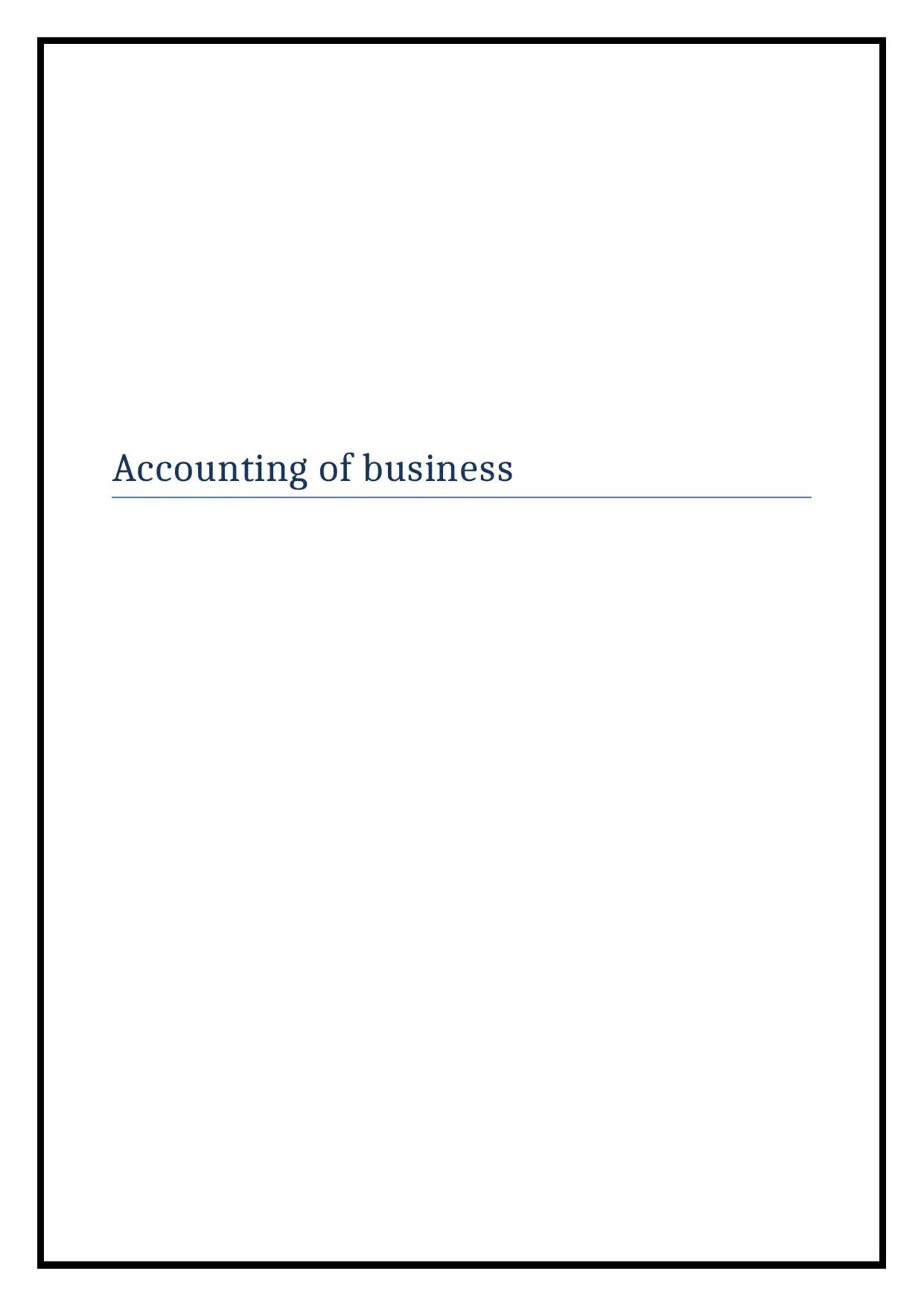
Accounting of business
Paraphrase This Document
Need a fresh take? Get an instant paraphrase of this document with our AI Paraphraser
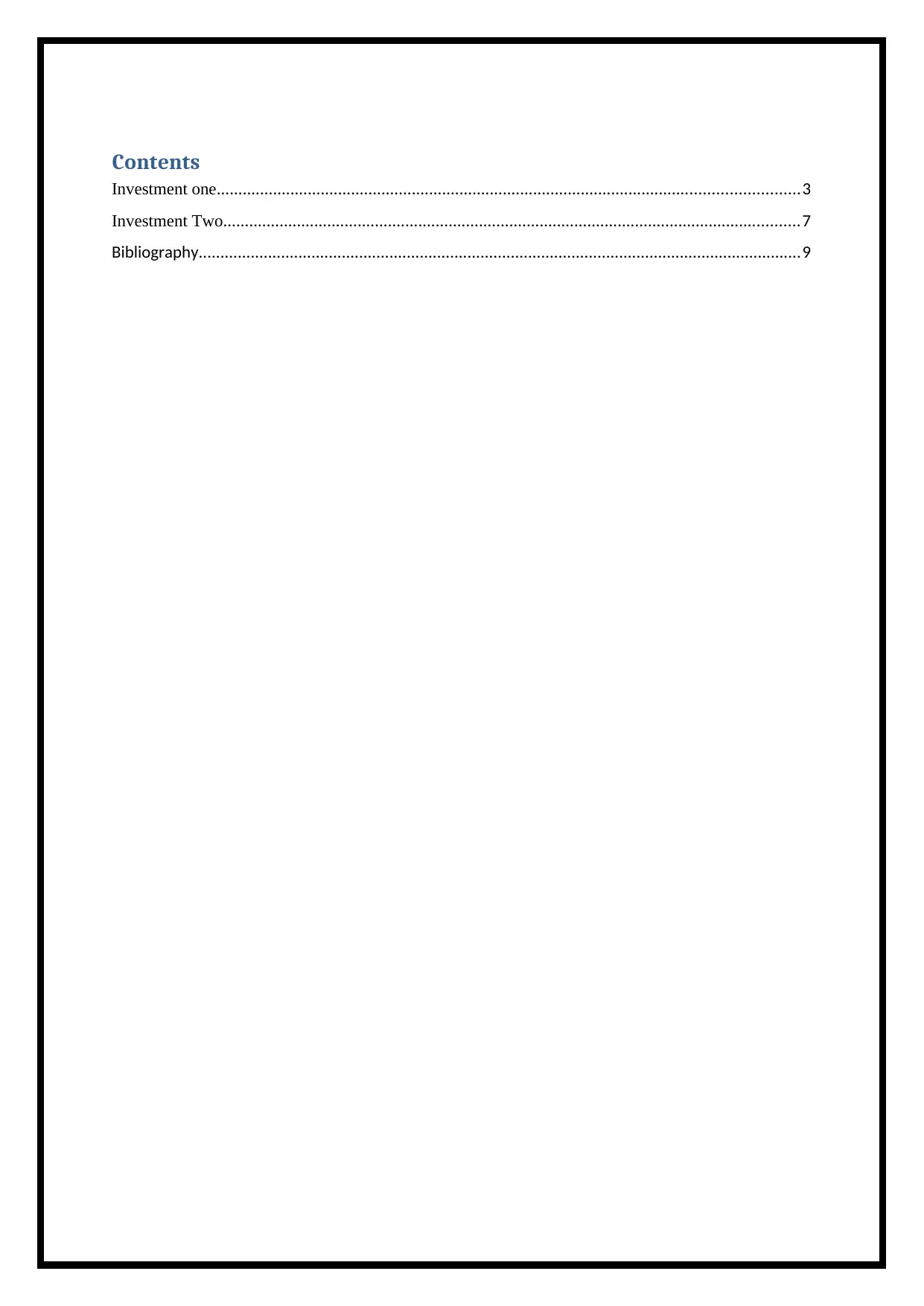
Contents
Investment one......................................................................................................................................3
Investment Two.....................................................................................................................................7
Bibliography...........................................................................................................................................9
Investment one......................................................................................................................................3
Investment Two.....................................................................................................................................7
Bibliography...........................................................................................................................................9
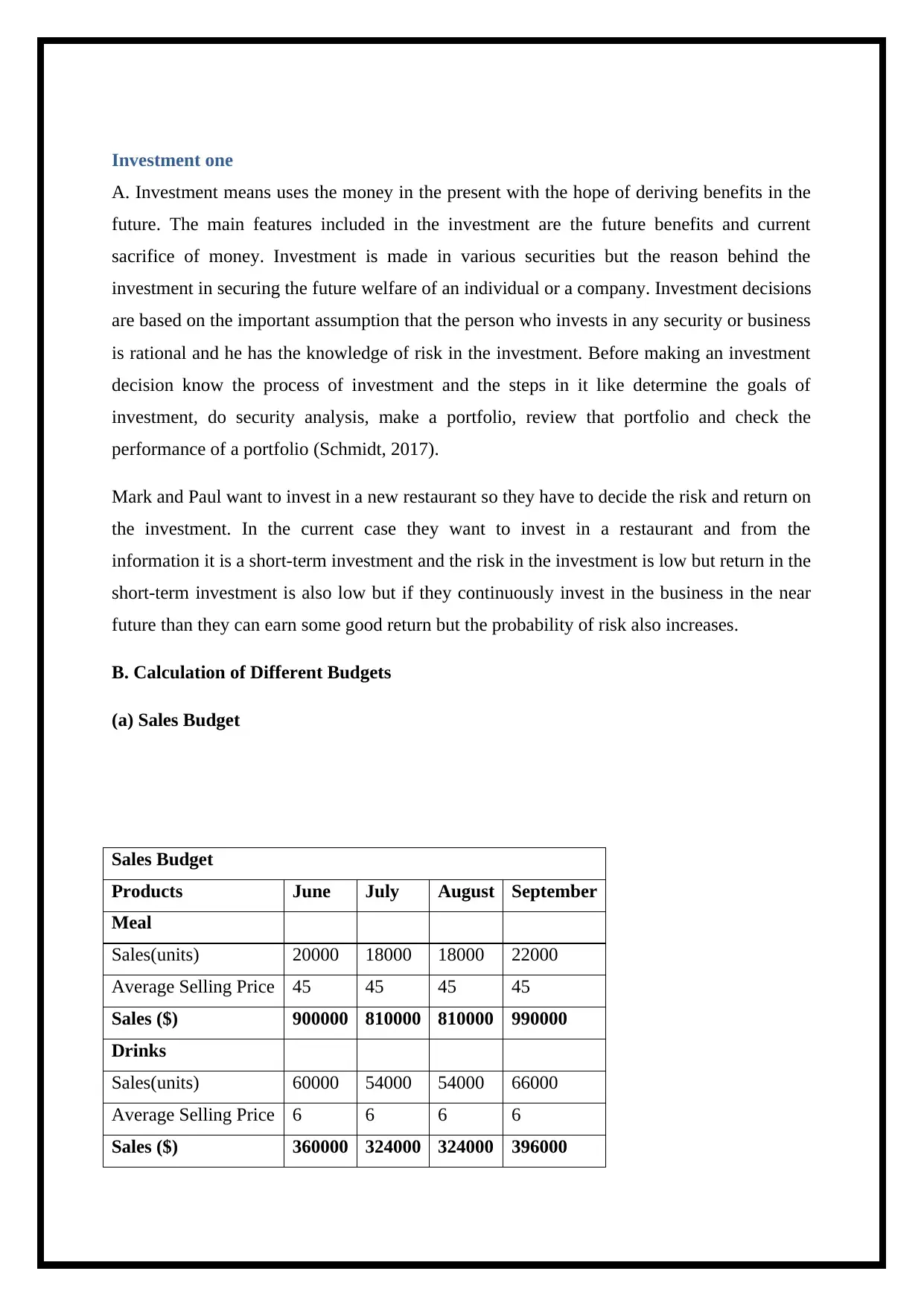
Investment one
A. Investment means uses the money in the present with the hope of deriving benefits in the
future. The main features included in the investment are the future benefits and current
sacrifice of money. Investment is made in various securities but the reason behind the
investment in securing the future welfare of an individual or a company. Investment decisions
are based on the important assumption that the person who invests in any security or business
is rational and he has the knowledge of risk in the investment. Before making an investment
decision know the process of investment and the steps in it like determine the goals of
investment, do security analysis, make a portfolio, review that portfolio and check the
performance of a portfolio (Schmidt, 2017).
Mark and Paul want to invest in a new restaurant so they have to decide the risk and return on
the investment. In the current case they want to invest in a restaurant and from the
information it is a short-term investment and the risk in the investment is low but return in the
short-term investment is also low but if they continuously invest in the business in the near
future than they can earn some good return but the probability of risk also increases.
B. Calculation of Different Budgets
(a) Sales Budget
Sales Budget
Products June July August September
Meal
Sales(units) 20000 18000 18000 22000
Average Selling Price 45 45 45 45
Sales ($) 900000 810000 810000 990000
Drinks
Sales(units) 60000 54000 54000 66000
Average Selling Price 6 6 6 6
Sales ($) 360000 324000 324000 396000
A. Investment means uses the money in the present with the hope of deriving benefits in the
future. The main features included in the investment are the future benefits and current
sacrifice of money. Investment is made in various securities but the reason behind the
investment in securing the future welfare of an individual or a company. Investment decisions
are based on the important assumption that the person who invests in any security or business
is rational and he has the knowledge of risk in the investment. Before making an investment
decision know the process of investment and the steps in it like determine the goals of
investment, do security analysis, make a portfolio, review that portfolio and check the
performance of a portfolio (Schmidt, 2017).
Mark and Paul want to invest in a new restaurant so they have to decide the risk and return on
the investment. In the current case they want to invest in a restaurant and from the
information it is a short-term investment and the risk in the investment is low but return in the
short-term investment is also low but if they continuously invest in the business in the near
future than they can earn some good return but the probability of risk also increases.
B. Calculation of Different Budgets
(a) Sales Budget
Sales Budget
Products June July August September
Meal
Sales(units) 20000 18000 18000 22000
Average Selling Price 45 45 45 45
Sales ($) 900000 810000 810000 990000
Drinks
Sales(units) 60000 54000 54000 66000
Average Selling Price 6 6 6 6
Sales ($) 360000 324000 324000 396000
⊘ This is a preview!⊘
Do you want full access?
Subscribe today to unlock all pages.

Trusted by 1+ million students worldwide
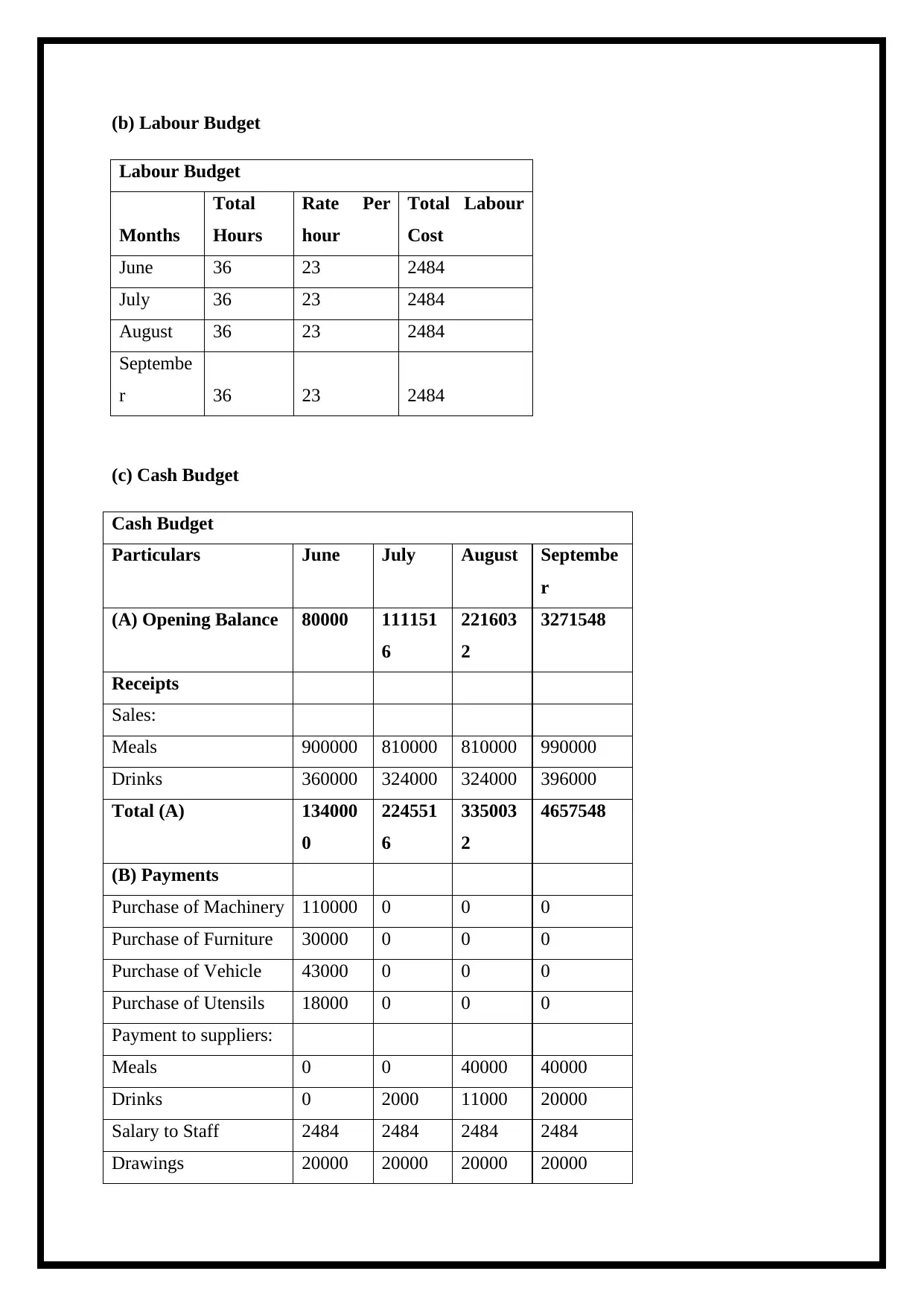
(b) Labour Budget
Labour Budget
Months
Total
Hours
Rate Per
hour
Total Labour
Cost
June 36 23 2484
July 36 23 2484
August 36 23 2484
Septembe
r 36 23 2484
(c) Cash Budget
Cash Budget
Particulars June July August Septembe
r
(A) Opening Balance 80000 111151
6
221603
2
3271548
Receipts
Sales:
Meals 900000 810000 810000 990000
Drinks 360000 324000 324000 396000
Total (A) 134000
0
224551
6
335003
2
4657548
(B) Payments
Purchase of Machinery 110000 0 0 0
Purchase of Furniture 30000 0 0 0
Purchase of Vehicle 43000 0 0 0
Purchase of Utensils 18000 0 0 0
Payment to suppliers:
Meals 0 0 40000 40000
Drinks 0 2000 11000 20000
Salary to Staff 2484 2484 2484 2484
Drawings 20000 20000 20000 20000
Labour Budget
Months
Total
Hours
Rate Per
hour
Total Labour
Cost
June 36 23 2484
July 36 23 2484
August 36 23 2484
Septembe
r 36 23 2484
(c) Cash Budget
Cash Budget
Particulars June July August Septembe
r
(A) Opening Balance 80000 111151
6
221603
2
3271548
Receipts
Sales:
Meals 900000 810000 810000 990000
Drinks 360000 324000 324000 396000
Total (A) 134000
0
224551
6
335003
2
4657548
(B) Payments
Purchase of Machinery 110000 0 0 0
Purchase of Furniture 30000 0 0 0
Purchase of Vehicle 43000 0 0 0
Purchase of Utensils 18000 0 0 0
Payment to suppliers:
Meals 0 0 40000 40000
Drinks 0 2000 11000 20000
Salary to Staff 2484 2484 2484 2484
Drawings 20000 20000 20000 20000
Paraphrase This Document
Need a fresh take? Get an instant paraphrase of this document with our AI Paraphraser
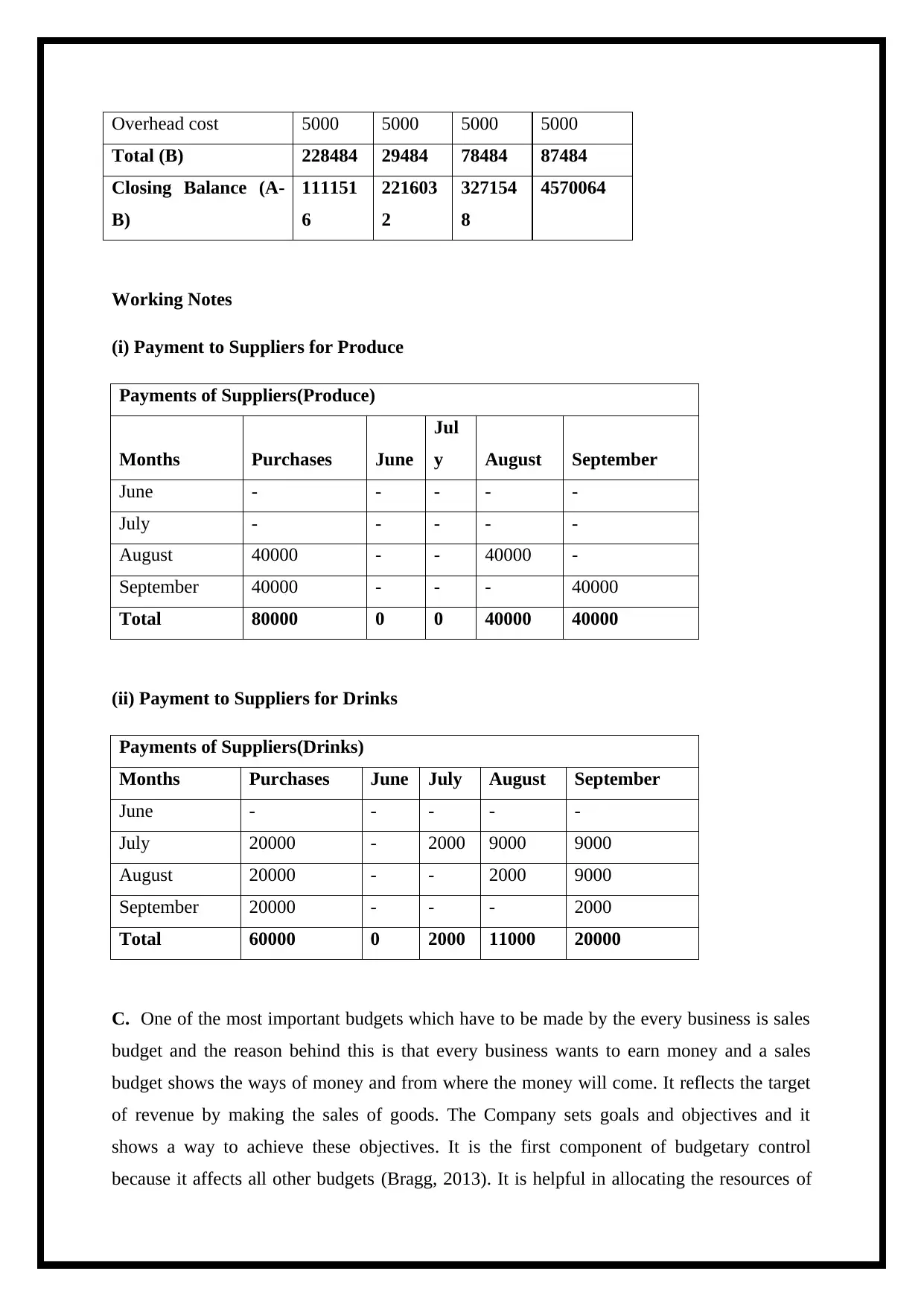
Overhead cost 5000 5000 5000 5000
Total (B) 228484 29484 78484 87484
Closing Balance (A-
B)
111151
6
221603
2
327154
8
4570064
Working Notes
(i) Payment to Suppliers for Produce
Payments of Suppliers(Produce)
Months Purchases June
Jul
y August September
June - - - - -
July - - - - -
August 40000 - - 40000 -
September 40000 - - - 40000
Total 80000 0 0 40000 40000
(ii) Payment to Suppliers for Drinks
Payments of Suppliers(Drinks)
Months Purchases June July August September
June - - - - -
July 20000 - 2000 9000 9000
August 20000 - - 2000 9000
September 20000 - - - 2000
Total 60000 0 2000 11000 20000
C. One of the most important budgets which have to be made by the every business is sales
budget and the reason behind this is that every business wants to earn money and a sales
budget shows the ways of money and from where the money will come. It reflects the target
of revenue by making the sales of goods. The Company sets goals and objectives and it
shows a way to achieve these objectives. It is the first component of budgetary control
because it affects all other budgets (Bragg, 2013). It is helpful in allocating the resources of
Total (B) 228484 29484 78484 87484
Closing Balance (A-
B)
111151
6
221603
2
327154
8
4570064
Working Notes
(i) Payment to Suppliers for Produce
Payments of Suppliers(Produce)
Months Purchases June
Jul
y August September
June - - - - -
July - - - - -
August 40000 - - 40000 -
September 40000 - - - 40000
Total 80000 0 0 40000 40000
(ii) Payment to Suppliers for Drinks
Payments of Suppliers(Drinks)
Months Purchases June July August September
June - - - - -
July 20000 - 2000 9000 9000
August 20000 - - 2000 9000
September 20000 - - - 2000
Total 60000 0 2000 11000 20000
C. One of the most important budgets which have to be made by the every business is sales
budget and the reason behind this is that every business wants to earn money and a sales
budget shows the ways of money and from where the money will come. It reflects the target
of revenue by making the sales of goods. The Company sets goals and objectives and it
shows a way to achieve these objectives. It is the first component of budgetary control
because it affects all other budgets (Bragg, 2013). It is helpful in allocating the resources of
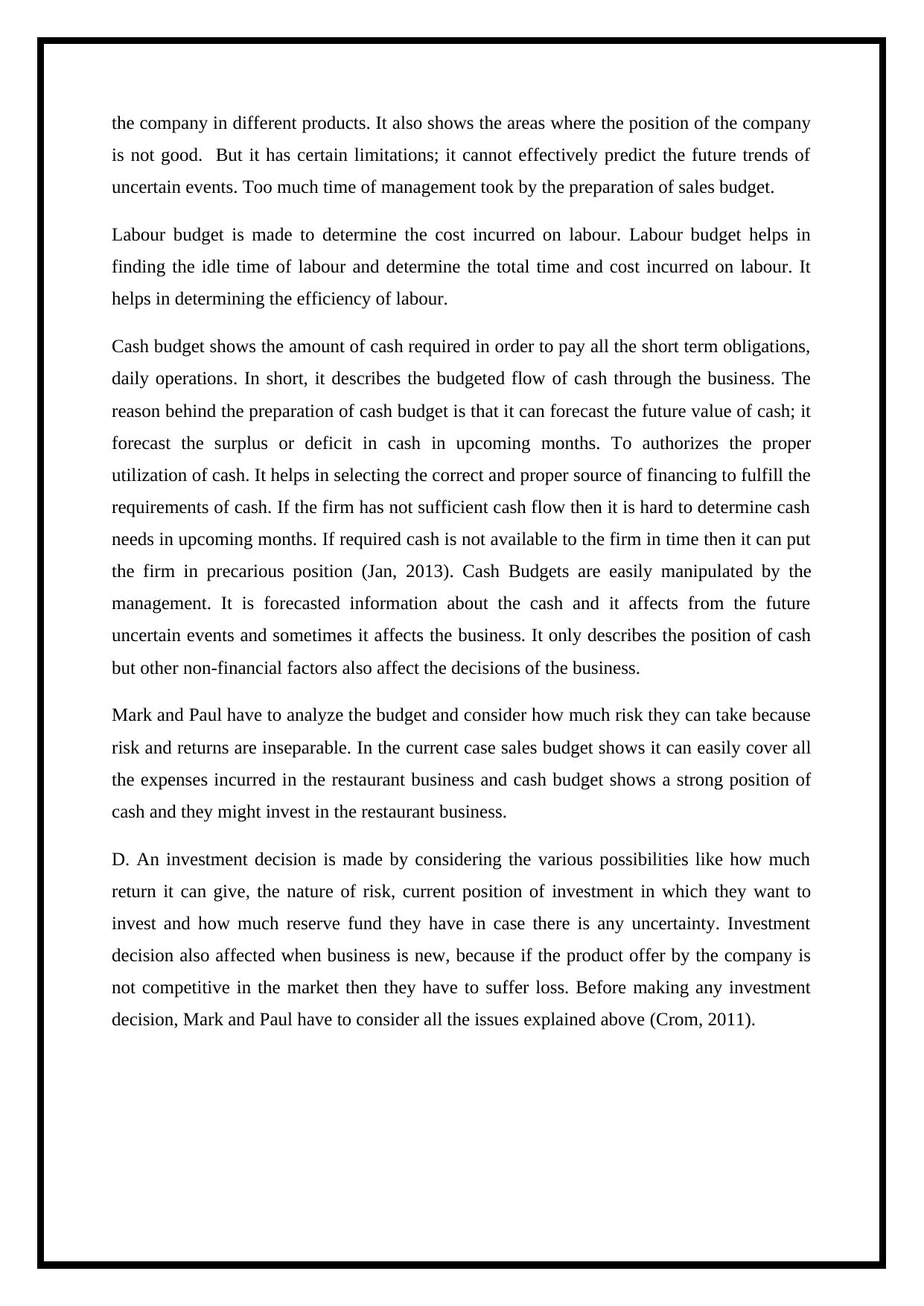
the company in different products. It also shows the areas where the position of the company
is not good. But it has certain limitations; it cannot effectively predict the future trends of
uncertain events. Too much time of management took by the preparation of sales budget.
Labour budget is made to determine the cost incurred on labour. Labour budget helps in
finding the idle time of labour and determine the total time and cost incurred on labour. It
helps in determining the efficiency of labour.
Cash budget shows the amount of cash required in order to pay all the short term obligations,
daily operations. In short, it describes the budgeted flow of cash through the business. The
reason behind the preparation of cash budget is that it can forecast the future value of cash; it
forecast the surplus or deficit in cash in upcoming months. To authorizes the proper
utilization of cash. It helps in selecting the correct and proper source of financing to fulfill the
requirements of cash. If the firm has not sufficient cash flow then it is hard to determine cash
needs in upcoming months. If required cash is not available to the firm in time then it can put
the firm in precarious position (Jan, 2013). Cash Budgets are easily manipulated by the
management. It is forecasted information about the cash and it affects from the future
uncertain events and sometimes it affects the business. It only describes the position of cash
but other non-financial factors also affect the decisions of the business.
Mark and Paul have to analyze the budget and consider how much risk they can take because
risk and returns are inseparable. In the current case sales budget shows it can easily cover all
the expenses incurred in the restaurant business and cash budget shows a strong position of
cash and they might invest in the restaurant business.
D. An investment decision is made by considering the various possibilities like how much
return it can give, the nature of risk, current position of investment in which they want to
invest and how much reserve fund they have in case there is any uncertainty. Investment
decision also affected when business is new, because if the product offer by the company is
not competitive in the market then they have to suffer loss. Before making any investment
decision, Mark and Paul have to consider all the issues explained above (Crom, 2011).
is not good. But it has certain limitations; it cannot effectively predict the future trends of
uncertain events. Too much time of management took by the preparation of sales budget.
Labour budget is made to determine the cost incurred on labour. Labour budget helps in
finding the idle time of labour and determine the total time and cost incurred on labour. It
helps in determining the efficiency of labour.
Cash budget shows the amount of cash required in order to pay all the short term obligations,
daily operations. In short, it describes the budgeted flow of cash through the business. The
reason behind the preparation of cash budget is that it can forecast the future value of cash; it
forecast the surplus or deficit in cash in upcoming months. To authorizes the proper
utilization of cash. It helps in selecting the correct and proper source of financing to fulfill the
requirements of cash. If the firm has not sufficient cash flow then it is hard to determine cash
needs in upcoming months. If required cash is not available to the firm in time then it can put
the firm in precarious position (Jan, 2013). Cash Budgets are easily manipulated by the
management. It is forecasted information about the cash and it affects from the future
uncertain events and sometimes it affects the business. It only describes the position of cash
but other non-financial factors also affect the decisions of the business.
Mark and Paul have to analyze the budget and consider how much risk they can take because
risk and returns are inseparable. In the current case sales budget shows it can easily cover all
the expenses incurred in the restaurant business and cash budget shows a strong position of
cash and they might invest in the restaurant business.
D. An investment decision is made by considering the various possibilities like how much
return it can give, the nature of risk, current position of investment in which they want to
invest and how much reserve fund they have in case there is any uncertainty. Investment
decision also affected when business is new, because if the product offer by the company is
not competitive in the market then they have to suffer loss. Before making any investment
decision, Mark and Paul have to consider all the issues explained above (Crom, 2011).
⊘ This is a preview!⊘
Do you want full access?
Subscribe today to unlock all pages.

Trusted by 1+ million students worldwide
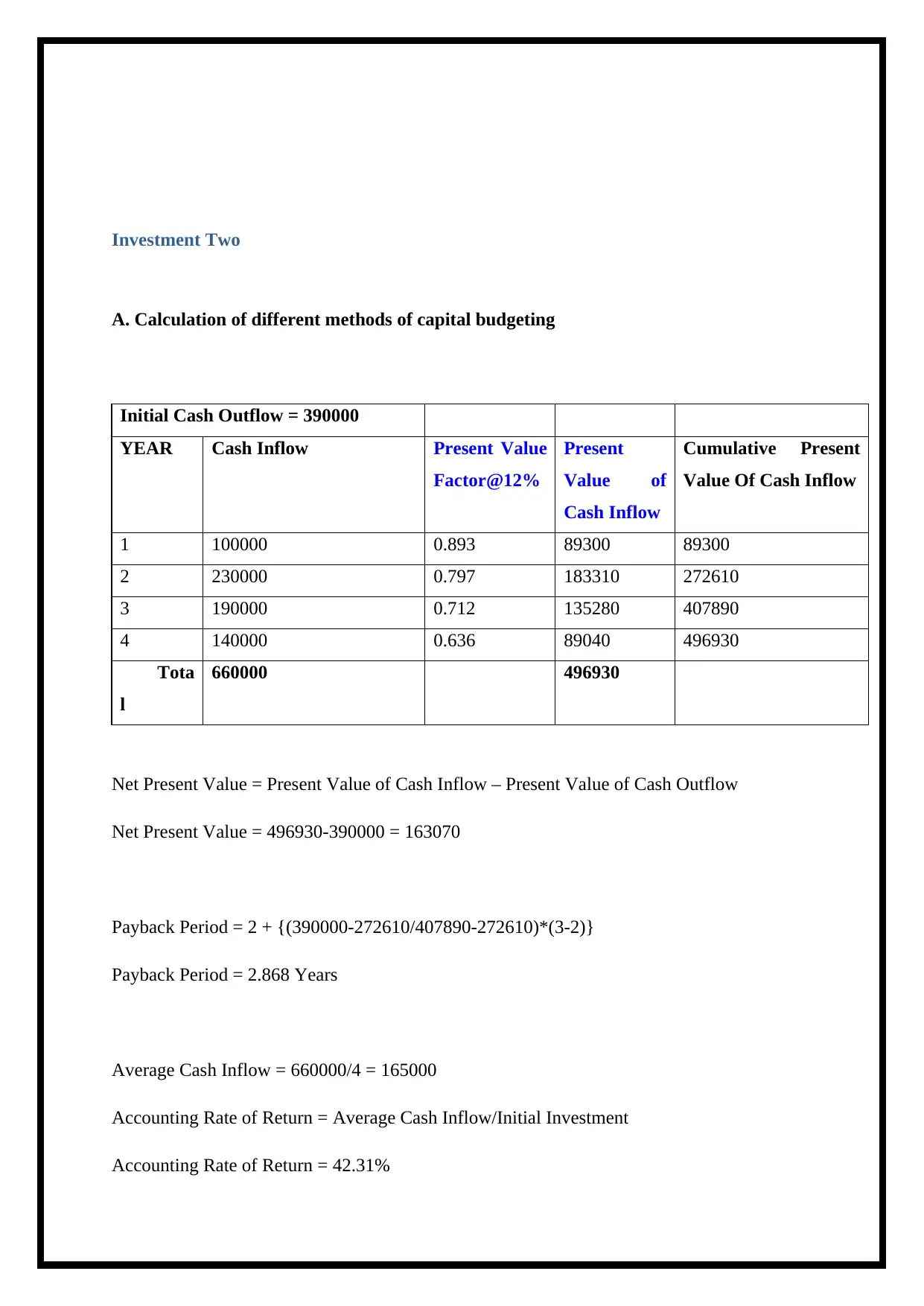
Investment Two
A. Calculation of different methods of capital budgeting
Initial Cash Outflow = 390000
YEAR Cash Inflow Present Value
Factor@12%
Present
Value of
Cash Inflow
Cumulative Present
Value Of Cash Inflow
1 100000 0.893 89300 89300
2 230000 0.797 183310 272610
3 190000 0.712 135280 407890
4 140000 0.636 89040 496930
Tota
l
660000 496930
Net Present Value = Present Value of Cash Inflow – Present Value of Cash Outflow
Net Present Value = 496930-390000 = 163070
Payback Period = 2 + {(390000-272610/407890-272610)*(3-2)}
Payback Period = 2.868 Years
Average Cash Inflow = 660000/4 = 165000
Accounting Rate of Return = Average Cash Inflow/Initial Investment
Accounting Rate of Return = 42.31%
A. Calculation of different methods of capital budgeting
Initial Cash Outflow = 390000
YEAR Cash Inflow Present Value
Factor@12%
Present
Value of
Cash Inflow
Cumulative Present
Value Of Cash Inflow
1 100000 0.893 89300 89300
2 230000 0.797 183310 272610
3 190000 0.712 135280 407890
4 140000 0.636 89040 496930
Tota
l
660000 496930
Net Present Value = Present Value of Cash Inflow – Present Value of Cash Outflow
Net Present Value = 496930-390000 = 163070
Payback Period = 2 + {(390000-272610/407890-272610)*(3-2)}
Payback Period = 2.868 Years
Average Cash Inflow = 660000/4 = 165000
Accounting Rate of Return = Average Cash Inflow/Initial Investment
Accounting Rate of Return = 42.31%
Paraphrase This Document
Need a fresh take? Get an instant paraphrase of this document with our AI Paraphraser
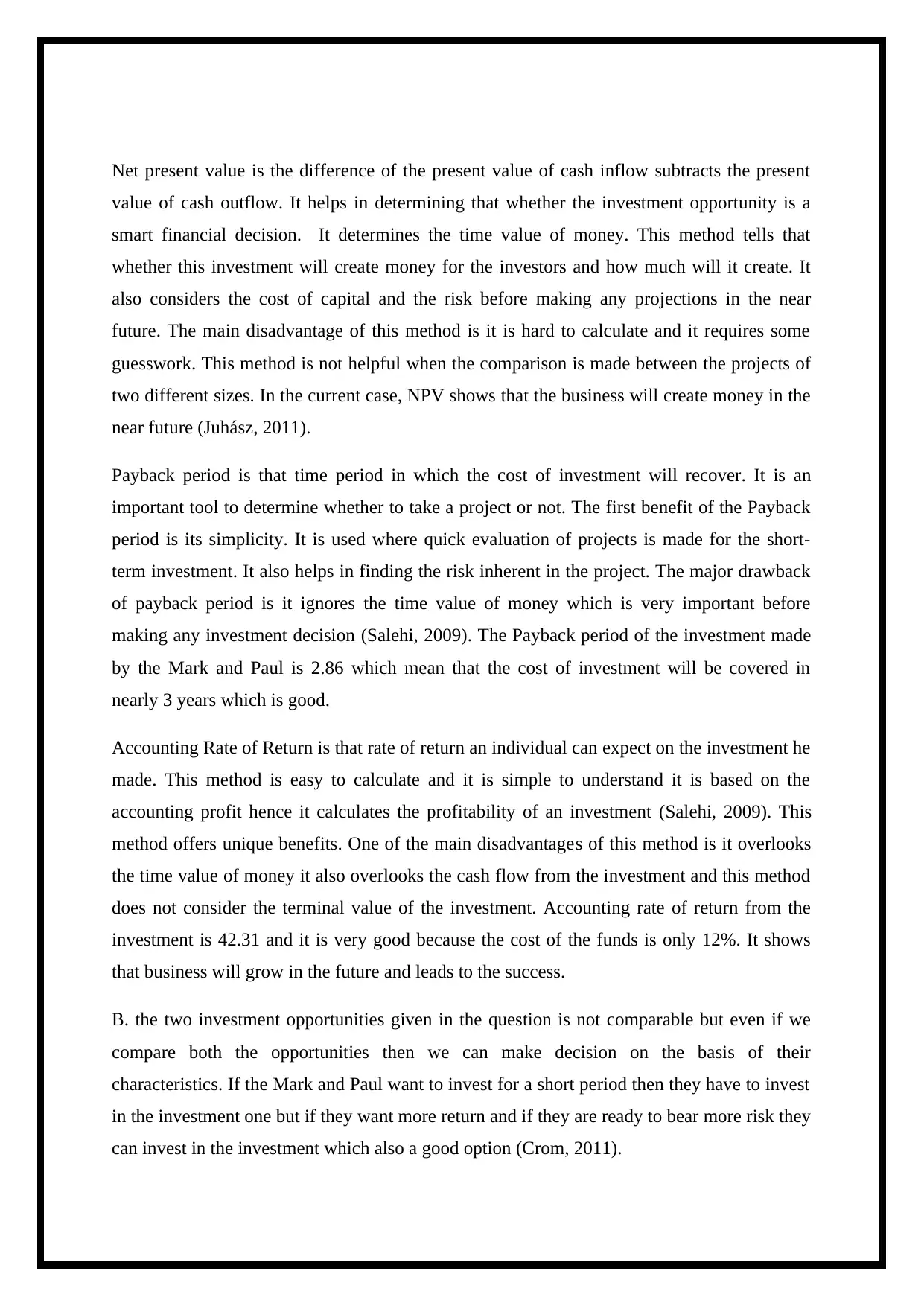
Net present value is the difference of the present value of cash inflow subtracts the present
value of cash outflow. It helps in determining that whether the investment opportunity is a
smart financial decision. It determines the time value of money. This method tells that
whether this investment will create money for the investors and how much will it create. It
also considers the cost of capital and the risk before making any projections in the near
future. The main disadvantage of this method is it is hard to calculate and it requires some
guesswork. This method is not helpful when the comparison is made between the projects of
two different sizes. In the current case, NPV shows that the business will create money in the
near future (Juhász, 2011).
Payback period is that time period in which the cost of investment will recover. It is an
important tool to determine whether to take a project or not. The first benefit of the Payback
period is its simplicity. It is used where quick evaluation of projects is made for the short-
term investment. It also helps in finding the risk inherent in the project. The major drawback
of payback period is it ignores the time value of money which is very important before
making any investment decision (Salehi, 2009). The Payback period of the investment made
by the Mark and Paul is 2.86 which mean that the cost of investment will be covered in
nearly 3 years which is good.
Accounting Rate of Return is that rate of return an individual can expect on the investment he
made. This method is easy to calculate and it is simple to understand it is based on the
accounting profit hence it calculates the profitability of an investment (Salehi, 2009). This
method offers unique benefits. One of the main disadvantages of this method is it overlooks
the time value of money it also overlooks the cash flow from the investment and this method
does not consider the terminal value of the investment. Accounting rate of return from the
investment is 42.31 and it is very good because the cost of the funds is only 12%. It shows
that business will grow in the future and leads to the success.
B. the two investment opportunities given in the question is not comparable but even if we
compare both the opportunities then we can make decision on the basis of their
characteristics. If the Mark and Paul want to invest for a short period then they have to invest
in the investment one but if they want more return and if they are ready to bear more risk they
can invest in the investment which also a good option (Crom, 2011).
value of cash outflow. It helps in determining that whether the investment opportunity is a
smart financial decision. It determines the time value of money. This method tells that
whether this investment will create money for the investors and how much will it create. It
also considers the cost of capital and the risk before making any projections in the near
future. The main disadvantage of this method is it is hard to calculate and it requires some
guesswork. This method is not helpful when the comparison is made between the projects of
two different sizes. In the current case, NPV shows that the business will create money in the
near future (Juhász, 2011).
Payback period is that time period in which the cost of investment will recover. It is an
important tool to determine whether to take a project or not. The first benefit of the Payback
period is its simplicity. It is used where quick evaluation of projects is made for the short-
term investment. It also helps in finding the risk inherent in the project. The major drawback
of payback period is it ignores the time value of money which is very important before
making any investment decision (Salehi, 2009). The Payback period of the investment made
by the Mark and Paul is 2.86 which mean that the cost of investment will be covered in
nearly 3 years which is good.
Accounting Rate of Return is that rate of return an individual can expect on the investment he
made. This method is easy to calculate and it is simple to understand it is based on the
accounting profit hence it calculates the profitability of an investment (Salehi, 2009). This
method offers unique benefits. One of the main disadvantages of this method is it overlooks
the time value of money it also overlooks the cash flow from the investment and this method
does not consider the terminal value of the investment. Accounting rate of return from the
investment is 42.31 and it is very good because the cost of the funds is only 12%. It shows
that business will grow in the future and leads to the success.
B. the two investment opportunities given in the question is not comparable but even if we
compare both the opportunities then we can make decision on the basis of their
characteristics. If the Mark and Paul want to invest for a short period then they have to invest
in the investment one but if they want more return and if they are ready to bear more risk they
can invest in the investment which also a good option (Crom, 2011).

⊘ This is a preview!⊘
Do you want full access?
Subscribe today to unlock all pages.

Trusted by 1+ million students worldwide
1 out of 9
Related Documents
Your All-in-One AI-Powered Toolkit for Academic Success.
+13062052269
info@desklib.com
Available 24*7 on WhatsApp / Email
![[object Object]](/_next/static/media/star-bottom.7253800d.svg)
Unlock your academic potential
Copyright © 2020–2025 A2Z Services. All Rights Reserved. Developed and managed by ZUCOL.




